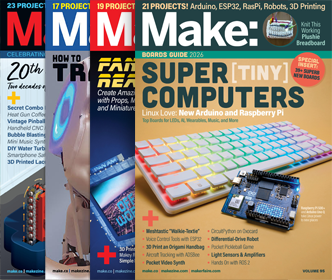 Russ writes – “For many years now, I have tinkered with all kinds of interesting projects, and have found a lot of fun in the realm of DIY gas turbine engines. These engines are based around turbochargers, but are in every sense real jets. They produce considerable thrust, and can even be used with afterburners. While I have been tinkering with one of these with a friend of mine, we debated on what kind of vehicle to put it on for testing. He suggested a small boat or a go cart. My theory was that if you really wanted to test out the speed of one of these, you would need a good long stretch of road. That being the case I thought it best to put the engine into a street legal frame. This is where the YSR came into my head. Firstly, a motorcycle would be perfect, as it is street legal, easily registered, and also has very little friction from the tires and wind drag.” Link.
Russ writes – “For many years now, I have tinkered with all kinds of interesting projects, and have found a lot of fun in the realm of DIY gas turbine engines. These engines are based around turbochargers, but are in every sense real jets. They produce considerable thrust, and can even be used with afterburners. While I have been tinkering with one of these with a friend of mine, we debated on what kind of vehicle to put it on for testing. He suggested a small boat or a go cart. My theory was that if you really wanted to test out the speed of one of these, you would need a good long stretch of road. That being the case I thought it best to put the engine into a street legal frame. This is where the YSR came into my head. Firstly, a motorcycle would be perfect, as it is street legal, easily registered, and also has very little friction from the tires and wind drag.” Link.
 Here’s a homemade remote control pan and tilt system mounted on a competition class RC car. All controlled wirelessly, with the video piped into a head mounted display. We’ve all seen those minicameras mounted on RC cars but never like this. Awesome mod! Link.
Here’s a homemade remote control pan and tilt system mounted on a competition class RC car. All controlled wirelessly, with the video piped into a head mounted display. We’ve all seen those minicameras mounted on RC cars but never like this. Awesome mod! Link.



 Handy Instructable from murph38_99 – “Create a USB car charger for any iPod or other Device that Charges Via USB by splicing together a car adapter that outputs 5v and USB Female plug. The most important part of this project is to make sure that the output your chosen car adapter is between 4.75v and 5.25v otherwise you risk damaging your device. Please verify voltage with a voltmeter.”
Handy Instructable from murph38_99 – “Create a USB car charger for any iPod or other Device that Charges Via USB by splicing together a car adapter that outputs 5v and USB Female plug. The most important part of this project is to make sure that the output your chosen car adapter is between 4.75v and 5.25v otherwise you risk damaging your device. Please verify voltage with a voltmeter.” 
 Wow, the folks at Seed magazine are cooking! New science blog network and a combined RSS feed for all of them, nicely done! – “ScienceBlogs is the web’s largest conversation about science. It features blogs from a wide array of scientific disciplines, with new voices coming on board regularly. It is a global, digital science salon.” [
Wow, the folks at Seed magazine are cooking! New science blog network and a combined RSS feed for all of them, nicely done! – “ScienceBlogs is the web’s largest conversation about science. It features blogs from a wide array of scientific disciplines, with new voices coming on board regularly. It is a global, digital science salon.” [
 Russ writes – “For many years now, I have tinkered with all kinds of interesting projects, and have found a lot of fun in the realm of DIY gas turbine engines. These engines are based around turbochargers, but are in every sense real jets. They produce considerable thrust, and can even be used with afterburners. While I have been tinkering with one of these with a friend of mine, we debated on what kind of vehicle to put it on for testing. He suggested a small boat or a go cart. My theory was that if you really wanted to test out the speed of one of these, you would need a good long stretch of road. That being the case I thought it best to put the engine into a street legal frame. This is where the YSR came into my head. Firstly, a motorcycle would be perfect, as it is street legal, easily registered, and also has very little friction from the tires and wind drag.”
Russ writes – “For many years now, I have tinkered with all kinds of interesting projects, and have found a lot of fun in the realm of DIY gas turbine engines. These engines are based around turbochargers, but are in every sense real jets. They produce considerable thrust, and can even be used with afterburners. While I have been tinkering with one of these with a friend of mine, we debated on what kind of vehicle to put it on for testing. He suggested a small boat or a go cart. My theory was that if you really wanted to test out the speed of one of these, you would need a good long stretch of road. That being the case I thought it best to put the engine into a street legal frame. This is where the YSR came into my head. Firstly, a motorcycle would be perfect, as it is street legal, easily registered, and also has very little friction from the tires and wind drag.” 
 We’ve had a few emails and posts about folks who wanted to build their own lie detector, here’s one (and how it works) – “The circuit diagram of the Lie Detector is shown above. It consists of three transistors (TR1 to TR3), a capacitor (C1), two lights or LEDs (L1 & L2), five resistors (R1 to R5), and a variable resistor (VR1). Suitable transistors to use are BC547, BC548 or BC549, or any other small NPN transistor. The Lie Detector circuit works based on the fact that a person’s skin resistance changes when they sweat (sweating because they’re lying). Dry skin has a resistance of about 1 million ohms, whereas the resistance of moist skin is reduced by a factor of ten or more.”
We’ve had a few emails and posts about folks who wanted to build their own lie detector, here’s one (and how it works) – “The circuit diagram of the Lie Detector is shown above. It consists of three transistors (TR1 to TR3), a capacitor (C1), two lights or LEDs (L1 & L2), five resistors (R1 to R5), and a variable resistor (VR1). Suitable transistors to use are BC547, BC548 or BC549, or any other small NPN transistor. The Lie Detector circuit works based on the fact that a person’s skin resistance changes when they sweat (sweating because they’re lying). Dry skin has a resistance of about 1 million ohms, whereas the resistance of moist skin is reduced by a factor of ten or more.”  If you like the MythBusters here are some videos they just posted of some of the out takes and things that didn’t appear on the show. Cola bits (cleaning things with cola), water torture, otter ping pong, live power lines, cement build up and plywood flight. [
If you like the MythBusters here are some videos they just posted of some of the out takes and things that didn’t appear on the show. Cola bits (cleaning things with cola), water torture, otter ping pong, live power lines, cement build up and plywood flight. [
 Ken writes “I work for a group at the University of Wisconsin that designs experiments in nanotechnology. While created with high school and/or college students in mind, the experiments may be interesting to your readers. Nanotechnology is a bit of a buzzword right now, and many people are surprised to learn that they can easily make things like nickel nanowires and organic light emitting diodes. The site includes materials lists and safety precautions. Full use of the site does require Quicktime.”
Ken writes “I work for a group at the University of Wisconsin that designs experiments in nanotechnology. While created with high school and/or college students in mind, the experiments may be interesting to your readers. Nanotechnology is a bit of a buzzword right now, and many people are surprised to learn that they can easily make things like nickel nanowires and organic light emitting diodes. The site includes materials lists and safety precautions. Full use of the site does require Quicktime.” 

